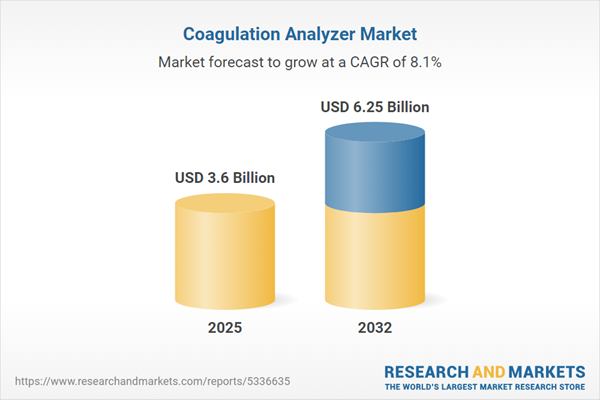Speak directly to the analyst to clarify any post sales queries you may have.
The Coagulation Analyzer Market is evolving rapidly as healthcare demand shifts toward improved diagnostics, automation, and integrated lab technologies. Senior decision-makers are presented with new opportunities and risks in an increasingly complex clinical diagnostics landscape.
Market Snapshot: Growth Outlook in the Coagulation Analyzer Market
The coagulation analyzer market grew from USD 3.34 billion in 2024 to USD 3.60 billion in 2025. It is expected to continue expanding at a CAGR of 8.14%, reaching USD 6.25 billion by 2032. This market progression reflects robust clinical adoption and rising investments in diagnostic infrastructure, particularly as automated and connected analyzer platforms become standard in both core labs and decentralized healthcare settings.
Scope & Segmentation of Coagulation Analyzer Market
- Operating Modes: Fully automated and semi-automated analyzer systems supporting variable workflow needs.
- Measurement Methods: Chromogenic, coagulometric, immunological, and turbidimetric approaches cater to a spectrum of hemostatic testing requirements.
- Configuration Types: Benchtop analyzers for established lab settings and portable analyzers for point-of-care or emergency scenarios.
- Technology Modalities: Incorporation of electrochemical, mechanical, and optical detection techniques for enhanced precision and throughput.
- Clinical Applications: Diagnostics cover hemophilia, impaired liver disorders, thrombocytopenia, thromboembolic disease, and Von Willebrand disease, addressing both routine and complex coagulation assessments.
- End Users: Diagnostic centers, hospitals, clinics, and research institutes access customized analyzer solutions according to their unique operational requirements.
- Distribution Channels: Sales occur via direct sales, distributor partners, and online platforms, supporting broad market reach and dynamic replenishment strategies.
- Regional Markets: Analysis spans the Americas, Europe, Middle East & Africa, and Asia-Pacific regions, with further detail by country and sub-region to reflect local clinical and procurement nuances.
- Company Coverage: Detailed evaluation includes A&T Corporation by Tokuyama Corporation, Abbott Laboratories, Autobio Diagnostics, Beijing Succeeder Technology Inc., Bpc Biosed Srl, Diagnostica Stago SAS, DIAGON Ltd., Diamond Diagnostics Inc., Erba Group, F. Hoffmann-La Roche Ltd., Genrui Biotech Inc., Globe Scientific Instruments, Helena Laboratories Corporation, Horiba Ltd, Maccura Biotechnology Co., Ltd., Medtronic PLC, Meril Life Sciences Pvt. Ltd, MICRO LAB INSTRUMENTS, Ozella, Siemens Healthcare AG, Sysmex Corporation, Thermo Fisher Scientific Inc., Trivitron Healthcare, VSI Electronics Pvt. Ltd., Werfen, S.A., Zhejiang Pushkang Biotechnology Co., Ltd.
Key Takeaways for Senior Decision-Makers
- Rising diagnostic complexity is prompting greater adoption of fully automated and integrated analyzer solutions across clinical environments.
- Technological advancement in digital connectivity and artificial intelligence is expanding system functions beyond core coagulation workflows, allowing real-time data and predictive maintenance.
- Increased regulatory requirements and rigorous accreditation standards are influencing procurement and product innovation, especially in established markets and emerging economies undergoing modernization.
- Point-of-care expansion and remote diagnostic options are enabling more agile patient care, with portable systems gaining ground in rural, emergency, and field settings.
- Strategic alliances, modular product lines, and value-based contracting are reshaping service models, with firms leveraging software partnerships and secure data ecosystems to enhance differentiation and customer loyalty.
- Regional differences in healthcare infrastructure, government incentives, and supply chain capabilities highlight the need for tailored go-to-market strategies and local market expertise.
Tariff Impact on Production and Supply Chains
Forthcoming changes to US tariff policies are anticipated to elevate input costs for imported analyzer components and consumables. Manufacturers are adapting by diversifying supplier networks, investing in regional sourcing partnerships, and optimizing inventory planning. These supply chain adjustments require robust quality protocols and may affect procurement cycles for healthcare providers. Companies can offset these pressures through localized reagent production and modular equipment designs, helping sustain performance under volatile trade conditions.
Methodology & Data Sources
Insights in this report stem from a combination of primary interviews with laboratory directors, clinical leaders, and procurement specialists, along with secondary research sourced from peer-reviewed studies, regulatory filings, and industry publications. Data triangulation and iterative validation sessions underpin the accuracy, ensuring the report’s findings are actionable for executive decision-making.
Why This Report Matters for B2B Leaders
- Gain a clear understanding of competitive dynamics, technology trends, and regulatory implications in the coagulation analyzer market.
- Identify strategic investment opportunities and potential supply chain vulnerabilities as you plan for expansion or risk mitigation.
- Build actionable strategies by leveraging segmentation insights tailored to your business needs and geographic focus.
Conclusion
This report offers critical analysis and actionable intelligence for navigating the evolving coagulation analyzer market. Harnessing digital innovation, supply chain flexibility, and targeted partnerships will be key to sustaining growth and operational resilience.
Additional Product Information:
- Purchase of this report includes 1 year online access with quarterly updates.
- This report can be updated on request. Please contact our Customer Experience team using the Ask a Question widget on our website.
Table of Contents
3. Executive Summary
4. Market Overview
7. Cumulative Impact of Artificial Intelligence 2025
Companies Mentioned
The companies profiled in this Coagulation Analyzer market report include:- A&T Corporation by Tokuyama Corporation
- Abbott Laboratories
- Autobio Diagnostics
- Beijing Succeeder Technology Inc.
- Bpc Biosed Srl
- Diagnostica Stago SAS
- DIAGON Ltd.
- Diamond Diagnostics Inc.
- Erba Group
- F. Hoffmann-La Roche Ltd.
- Genrui Biotech Inc.
- Globe Scientific Instruments
- Helena Laboratories Corporation
- Horiba, Ltd
- Maccura Biotechnology Co., Ltd.
- Medtronic PLC
- Meril Life Sciences Pvt. Ltd
- MICRO LAB INSTRUMENTS
- Ozella
- Siemens Healthcare AG
- Sysmex Corporation
- Thermo Fisher Scientific Inc.
- Trivitron Healthcare
- VSI Electronics Pvt. Ltd.
- Werfen, S.A.
- Zhejiang Pushkang Biotechnology Co., Ltd.
Table Information
| Report Attribute | Details |
|---|---|
| No. of Pages | 195 |
| Published | November 2025 |
| Forecast Period | 2025 - 2032 |
| Estimated Market Value ( USD | $ 3.6 Billion |
| Forecasted Market Value ( USD | $ 6.25 Billion |
| Compound Annual Growth Rate | 8.1% |
| Regions Covered | Global |
| No. of Companies Mentioned | 27 |









